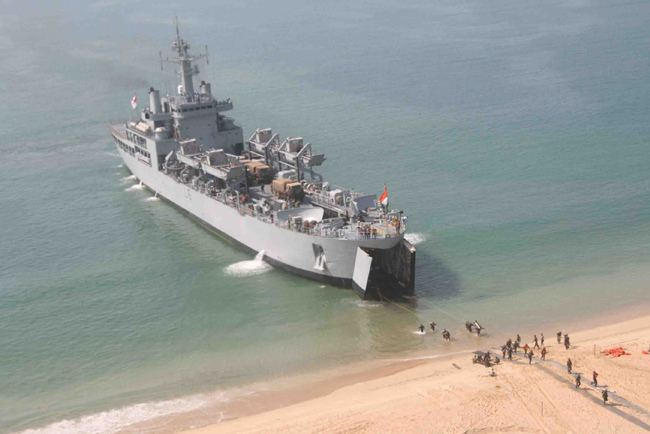Name INS Airavat Yard number Yard 3016 Launched 27 March 2006 Weight 5,741 tons Draft 4 m | Commissioned 19 May 2009 Construction started 2004 Length 125 m Displacement 5.126 million kg | |
 | ||
Builder Garden Reach Shipbuilders & Engineers | ||
INS Airavat is the third Shardul-class amphibious warfare vessel of the Indian Navy.
Contents
History
INS Airavat was built by Garden Reach Shipbuilders & Engineers in Kolkata at Yard 3016. She began sea trials in July 2008 after completing basin trials in May. She was commissioned at the Eastern Naval Command in Visakhapatnam on 19 May 2009, by the Chief of Naval Staff, Admiral Sureesh Mehta. She is named for the mount of god Indra, the elephant Airavata, as mentioned in the Rigveda.
Design
Safety features aboard the Airavat include anti-roll flume stabilisation system, smoke curtains to impede spreading of smoke and toxic gases in case of fire, as well as battle damage control systems. Fully loaded, she can operate independently at high seas for up to 45 days.
While primarily designed for amphibious assault operations, Airavat's missions also include humanitarian assistance & disaster relief (HADR) during natural disasters, including tsunamis, cyclones and earthquakes. She has a fully functioning hospital on-board, the capacity to carry 500 soldiers, and can provide stern refuelling for other naval vessels.
Primary suppliers for her equipment are Bharat Electronics Limited, Kirloskar, Larsen & Toubro, Hindustan Aeronautics Limited, Keltron and the Godrej Group.
Deployments
On 11 July 2011, INS Airavat made a goodwill visit to Sihanoukville, Cambodia. Between 19 and 28 July 2011, she made courtesy calls at Nha Trang and Hai Phong in Vietnam.
On 1 May 2016, INS Airavat arrived at Brunei to participate in the ADMM Plus (ASEAN Defence Ministers Meeting Plus) Exercise on Maritime Security and Counter Terrorism(Ex MS & CT) which took place from 1–9 May 2016. During the exercise, she engaged with participating navies from Brunei, Singapore, Indonesia, Philippines, Thailand, Vietnam, Malaysia, Myanmar, China, Japan, Russia, Australia, Republic of Korea and the United States, through professional interactions in harbor and complex operations at sea.
